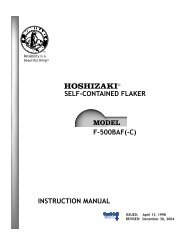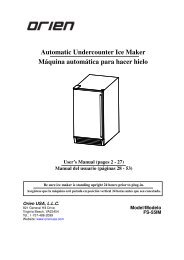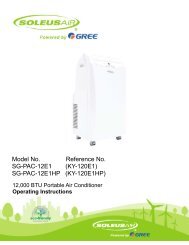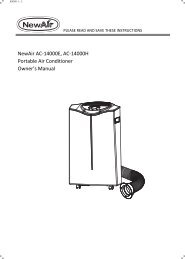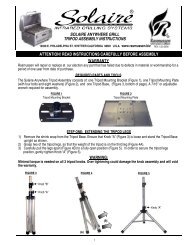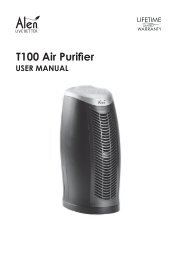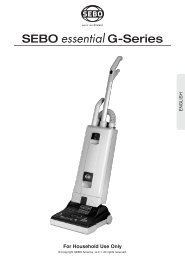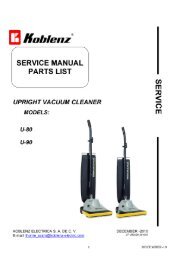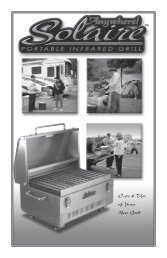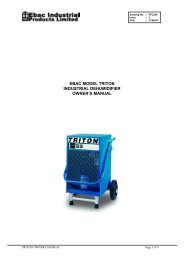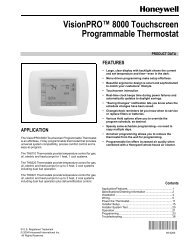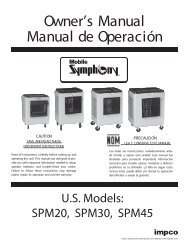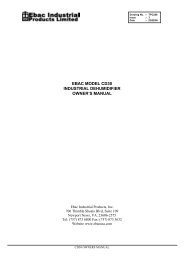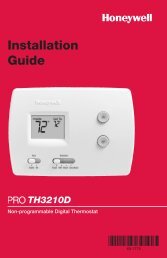68-0133 - Y8610U Intermittent Pilot Retrofit Kit - Air & Water
68-0133 - Y8610U Intermittent Pilot Retrofit Kit - Air & Water
68-0133 - Y8610U Intermittent Pilot Retrofit Kit - Air & Water
Create successful ePaper yourself
Turn your PDF publications into a flip-book with our unique Google optimized e-Paper software.
PLANNING THE INSTALLATION<br />
<strong>Intermittent</strong> pilot systems are used on various types of central<br />
heating equipment and on heating appliances such as<br />
commercial cookers, agricultural equipment, industrial<br />
heating equipment, and pool heaters. Some of these<br />
applications can make heavy demands on the controls, either<br />
because of frequent cycling or because of moisture, corrosive<br />
chemicals, dust, or excessive heat in the environment. In<br />
these applications, special steps could be required to prevent<br />
nuisance shutdowns and premature control failure. These<br />
applications require Honeywell Home and Building Control<br />
Engineering review; contact your Honeywell Sales<br />
Representative for assistance.<br />
Frequent Cycling<br />
These controls are designed for use on space heating<br />
appliances that typically cycle three to four times an hour<br />
during the heating season and not at all during the cooling<br />
season. In applications with significantly greater cycling rates<br />
and longer heating seasons, we recommend monthly<br />
checkout because the controls can wear out more quickly.<br />
<strong>Water</strong> or Steam Cleaning<br />
Once a module or gas control has been wet, it can operate<br />
unreliably and must be replaced. If the appliance is cleaned<br />
with water or steam, the controls and associated wiring<br />
should be covered so water or steam flow cannot reach them.<br />
The controls should be high enough above the cabinet<br />
bottom so flooding or splashing water can not reach them<br />
during normal cleaning procedures. If necessary, shield the<br />
controls to protect them from splashing water. A NEMA 4<br />
enclosure is recommended for the ignition module; see the<br />
Electronic Ignition Service Manual, form 70-6604.<br />
High Humidity or Dripping <strong>Water</strong><br />
Over time, dripping water or high ambient humidity can create<br />
unwanted electrical paths on the module circuit board,<br />
causing the module to fail. Never install an appliance where<br />
water can drip on the controls.<br />
In addition, high ambient humidity can cause the gas control<br />
to corrode, and finally to fail.<br />
When the appliance is installed in a humid atmosphere, make<br />
sure air circulation around the module and gas control is<br />
adequate to prevent condensation. It is also important to<br />
regularly check out the system. A NEMA 4 enclosure could be<br />
needed; see the Electronic Ignition Service Manual,<br />
form 70-6604.<br />
Corrosive Chemicals<br />
Corrosive chemicals can also attack the module and gas<br />
control and eventually cause a failure. Where chemicals are<br />
used routinely for cleaning, make sure the cleaning solution<br />
cannot reach the controls. Where chemicals could be<br />
suspended in air, as in some industrial and agricultural<br />
applications, protect the ignition module from exposure with a<br />
NEMA 4 enclosure; see the Electronic Ignition Service<br />
Manual, form 70-6604.<br />
Dust or Grease Accumulation<br />
Heavy accumulation of dust or grease can cause the controls<br />
to malfunction. Where dust or grease can cause a problem,<br />
5<br />
<strong>Y8610U</strong> INTERMITTENT PILOT RETROFIT KIT<br />
provide covers for the module and the gas control that emit<br />
environmental contamination. A NEMA 4 enclosure is<br />
recommended for the ignition module; see the Electronic<br />
Ignition Service Manual, form 70-6604.<br />
Heat<br />
The controls can be damaged by excessively high<br />
temperatures. Make sure the maximum ambient temperature<br />
at the control location does not exceed the rating of the<br />
control. If the appliance normally operates at very high<br />
temperatures; insulation, shielding, and air circulation could<br />
be necessary to protect the controls. Proper insulation or<br />
shielding should be provided by the appliance manufacturer;<br />
make sure adequate air circulation is maintained when the<br />
appliance is installed.<br />
INSTALLATION<br />
When Installing this Product…<br />
1. Read these instructions carefully. Failure to follow them<br />
could damage the product or cause a hazardous<br />
condition.<br />
2. Check the ratings given in these instructions and on the<br />
product to ensure the product is suitable for your<br />
application.<br />
3. Installer must be a trained, experienced service<br />
technician.<br />
4. After completing installation, use these instructions to<br />
check product operation.<br />
IMPORTANT<br />
1. Installer must comply with local codes and<br />
ordinances of the National Fuel Code (ANSI<br />
Z223.1—NFPA No. 54) and National Electrical Code<br />
(ANSI NFPA No. 70).<br />
2. Installer must fill in and attach label to appliance<br />
being converted.<br />
3. Use Y8610 <strong>Retrofit</strong> <strong>Kit</strong> only with atmospheric<br />
burners. Do not use on direct vent appliances or<br />
power burners.<br />
4. Do not use the Y8610 <strong>Retrofit</strong> <strong>Kit</strong> with mercury pilots<br />
or 250 to 750 mV pilot systems.<br />
WARNING<br />
FIRE OR EXPLOSION HAZARD<br />
CAN CAUSE PROPERTY DAMAGE,<br />
SEVERE INJURY, OR DEATH.<br />
Follow these warnings exactly:<br />
1. Disconnect the power supply before wiring to<br />
prevent electrical shock or equipment damage.<br />
2. To avoid dangerous accumulation of fuel gas,<br />
turn off gas supply at the appliance service valve<br />
before starting Installation and perform the Gas<br />
Leak Test immediately following the installation.<br />
3. Never install where water can flood, drip, or<br />
condense on module or gas control. Never use a<br />
module or gas control that has been wet. If wet,<br />
controls can malfunction and lead to an<br />
accumulation of explosive gas.<br />
4. Do not light or operate electric switches, lights, or<br />
appliances until you are sure the appliance area<br />
is free of gas. Liquefied petroleum (LP) gas is<br />
heavier than air and does not vent upward<br />
naturally.<br />
<strong>68</strong>-<strong>0133</strong>—2



